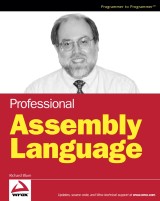Details

Professional Assembly Language
1. Aufl.
|
35,99 € |
|
| Verlag: | Wiley |
| Format: | |
| Veröffentl.: | 08.02.2005 |
| ISBN/EAN: | 9780764595615 |
| Sprache: | englisch |
| Anzahl Seiten: | 576 |
DRM-geschütztes eBook, Sie benötigen z.B. Adobe Digital Editions und eine Adobe ID zum Lesen.
Beschreibungen
<ul> <li>Unlike high-level languages such as Java and C++, assembly language is much closer to the machine code that actually runs computers; it's used to create programs or modules that are very fast and efficient, as well as in hacking exploits and reverse engineering</li> <li>Covering assembly language in the Pentium microprocessor environment, this code-intensive guide shows programmers how to create stand-alone assembly language programs as well as how to incorporate assembly language libraries or routines into existing high-level applications</li> <li>Demonstrates how to manipulate data, incorporate advanced functions and libraries, and maximize application performance</li> <li>Examples use C as a high-level language, Linux as the development environment, and GNU tools for assembling, compiling, linking, and debugging</li> </ul>
Acknowledgments. <p>Contents.</p> <p>Introduction.</p> <p>Chapter 1: What Is Assembly Language?</p> <p>Chapter 2: The IA-32 Platform.</p> <p>Chapter 3: The Tools of the Trade.</p> <p>Chapter 4: A Sample Assembly Language Program.</p> <p>Chapter 5: Moving Data.</p> <p>Chapter 6: Controlling Execution Flow.</p> <p>Chapter 7: Using Numbers.</p> <p>Chapter 8: Basic Math Functions.</p> <p>Chapter 9: Advanced Math Functions.</p> <p>Chapter 10: Working with Strings.</p> <p>Chapter 11: Using Functions.</p> <p>Chapter 12: Using Linux System Calls.</p> <p>Chapter 13: Using Inline Assembly.</p> <p>Chapter 14: Calling Assembly Libraries.</p> <p>Chapter 15: Optimizing Routines.</p> <p>Chapter 16: Using Files.</p> <p>Chapter 17: Using Advanced IA-32 Features.</p> <p>Index.</p>
<b>Richard Blum</b> has worked for a large U.S. government organization for more than 15 years. During that time, he has had the opportunity to program utilities in various programming languages: C, C++, Java, and Microsoft VB.NET and C#. With this experience, Rich has often found the benefit of reviewing assembly language code generated by compilers and utilizing assembly language routines to speed up higher-level language programs.<br /> Rich has a bachelor of science degree in electrical engineering from Purdue University, where he worked on many assembly language projects. (Of course, this was back in the eight-bit processor days.) He also has a master of science degree in management from Purdue University, specializing in Management Information Systems.
Professional Assembly Language <p>Every high level language program (such as C and C++) is converted by a compiler into assembly language before it is linked into an executable program. This book shows you how to view the assembly language code generated by the compiler and understand how it is created. With that knowledge you can tweak the assembly language code generated by the compiler or create your own assembly language routines.</p> <p>This code-intensive guide is divided into three sections — basics of the assembly language program development environment, assembly language programming, and advanced assembly language techniques. It shows how to decipher the compiler-generated assembly language code, and how to make functions in your programs faster and more efficient to increase the performance of an application.</p> <p>What you will learn from this book:</p> <ul> <li>The benefits of examining the assembly language code generated from your high-level language program</li> <li>How to create stand-alone assembly language programs for the Linux Pentium environment</li> <li>Ways to incorporate advanced functions and libraries in assembly language programs</li> <li>How to incorporate assembly language routines in your C and C++ applications</li> <li>Ways to use Linux system calls in your assembly language programs</li> <li>How to utilize Pentium MMX and SSE functions in your applications</li> </ul>
Diese Produkte könnten Sie auch interessieren:

Pattern-Oriented Software Architecture, Patterns for Resource Management

von: Michael Kircher, Prashant Jain

33,99 €















